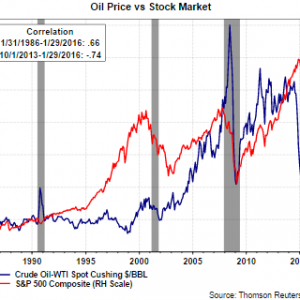Latest Posts
-
Finance 0
10 Qualities That Successful Traders Have And You Need
In tough times like 2016, traders often feel as though things can never go their way. This feeling typifies how stock trading can be incredibly emotional. We all want to make money, and that can mean chasing a stock on its way up or calling a bottom on its way down. Everyone has bought a stock at one point or another because they felt like it “just can’t go any lower” or “this rally is just getting started.” But the traders who consistently beat the market are those who realize that emotion has nothing to do with the performance of a stock. These successful traders also obtain many other qualities; today’s article highlights 10 of...On January 31, 2016 / By Kurt Osterberg -
Finance 0
BlackRock – Where To Ride Out The Volatility
By Russ Koestrich of Blackrockblog.com The one word that characterizes financial markets today: volatile. Take last week’s gyrations. Stocks sold off aggressively for most of the week on concerns about plunging oil, falling U.S. earnings estimates, China and slowing global growth. Amid the selloff, Japanese, U.K. and French stocks all entered bear market territory, according to MSCI index data accessible via Bloomberg. Then, markets rebounded strongly late in the week, thanks in part to dovish comments from the European Central Bank (ECB). Indeed, volatility measures have spiked to multi-month highs lately, with 2016 experiencing the ...On January 31, 2016 / By Kurt Osterberg -
Finance 0
A-B-C Correction Unfolding
Market Overview After the first rally from the 1812 low topped, it was unclear if we had completed the “bear market” rally or if more was to come. The congestion level which SPX produced over the next few days was either accumulation or distribution, but the bias was deemed to be on the downside since the resulting count matched precisely the top P&F projection. For it to be confirmed, however, the September low of 1872 would have to be breached. In spite of a strong attempt to do so after the FOMC statement was released, it held; and a continued oversold rally in oil along with the Japanese move to negative rates finally tipped the o...On January 31, 2016 / By Kurt Osterberg -
Finance 0
Understanding The Disconnect In The Correlation Between Oil And Stock Prices
Recently a number of commentators on the weekly business shows have commented oil prices and the stock market have been moving in the same direction during the month of January. On the few days oil and stocks moved in opposite directions, the conclusion was this would be a good thing for the overall market. Not wanting to single out any one specific strategist, but this past Monday, Bill Stone, chief investment strategist at PNC Wealth Management, noted on CNBC, “it’s not clear whether the selling will subside for now because of the tight correlation between stocks and oil prices, which he says should break at some point (emphas...On January 31, 2016 / By Kurt Osterberg -
Finance 0
Forex Forecast: Pairs In Focus – 1/31/2016
The difference between success and failure in Forex trading is very likely to depend upon which currency pairs you choose to trade each week, and not on the exact trading methods you might use to determine trade entries and exits. Each week I am going to analyze fundamentals, sentiment and technical positions in order to determine which currency pairs are most likely to produce the easiest and most profitable trading opportunities over the next week. In some cases it will be trading the trend. In other cases it will be trading support and resistance levels during more ranging markets. Big Picture 31st January 2016 Last week I highlighted shor...On January 31, 2016 / By Kurt Osterberg -
Finance 0
Is The Once Mighty Amazon Suffering
Amazon (Nasdaq: AMZN) is the world’s most profitable online technology company, with a market capitalization of $273.56 billion at a share price of $583.16. However if you, like me, have been watching the stock price recently your pulse will be racing as the losses pile up. Just recently, Amazon released its Q4, 2015 earnings results and the figures missed the mark in a big way. Clearly, December retail sales were not quite what the world’s premier online retail giant expected them to be, and it is showing in the final quarter’s results. The earnings per share (EPS) came in at $1, versus the expected earnings per share (EPS) of $1.56...On January 31, 2016 / By Kurt Osterberg -
Finance 0
The Fed Messed Up
This post will build upon my previous post with the Cobra equation. In that post, I gave a model showing that the Fed is completely behind the curve of the business cycle. The Fed should not be raising rates at this point in the business cycle. When to Normalize in Theory In the model, aggregate profit rates have a somewhat circular movement through a business cycle. I say somewhat because in other business cycles, the circular movement looks more like a bouncing ball off of the effective demand limit. In the green portion of the cycle, aggregate profit rates are increasing. There is broad momentum to expand utilization of labor and capital....On January 31, 2016 / By Kurt Osterberg -
Finance 0
Will Box Be Profitable In 2016?
Shareholders have suffered significant losses from the Box IPO. Their CEO claims that the company’s negative operating margin will turn to positive cash flow by the fourth quarter of 2016. If revenues continue to climb and Box can turn positive cash flow then it presents a huge opportunity for investors, however timing is important. Investors who got in on the Box IPO last year have been seriously burned as the stock has tumbled nearly 60%. With an operating margin of -70%, it raises the question whether Box (NYSE:BOX) will ever be profitable, or if their business is even viable. Source: BOX stock price chart by amigobulls.com S...On January 31, 2016 / By Kurt Osterberg -
Finance 0
US Equity And Economic Review: It’s A Slowdown, Not A Recession
Bearish calls on the US economy increased measurably since the first of the year. It’s obviously the result of increase market volatility and weaker economic numbers since the first of the year. But a few key stories this week point to data indicating we’re not in a recession. While industrial weakness is a primary reason for my recent bearishness, Tim Duy noted that the breadth of weak industrial numbers is very small: The point is that during a recession, the vast majority of manufacturing industries (or all!) are declining. We are nowhere near that point. In other words, even manufacturing – arguably the most distressed sector...On January 31, 2016 / By Kurt Osterberg -
Finance 0
Review: DIY Financial Advisor
It’s probably bad form of me to slander my own profession, but sometimes it is roundly deserved. So today, I’m going to share some of the insights of Wesley Gray, Jack Vogel and David Foulke in their 2015 book DIY Financial Advisor. “DIY” stands for do it yourself, of course. And that’s what Gray and his colleagues aim to do. The book shows how retail investors can replace an expensive financial advisor – who may very well be underperforming the market and offering nothing in the way of financial advice that you can’t get elsewhere for far cheaper – with simple, repeatable investment systems. While a good advisor is still w...On January 31, 2016 / By Kurt Osterberg
Top Posts
-
 The Importance for Individuals to Use Sustainable Chemicals
The Importance for Individuals to Use Sustainable Chemicals
-
 Small Businesses: Finding the Right Candidate for the Job
Small Businesses: Finding the Right Candidate for the Job
-
 How to Write the Perfect Thank You Letter After Your Job Interview
How to Write the Perfect Thank You Letter After Your Job Interview
-
 3 Best Large-Cap Blend Mutual Funds For Enticing Returns
3 Best Large-Cap Blend Mutual Funds For Enticing Returns
-
 China suspected in massive breach of federal personnel data
China suspected in massive breach of federal personnel data









